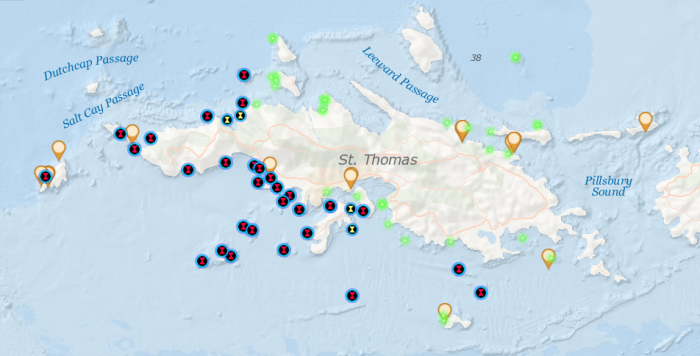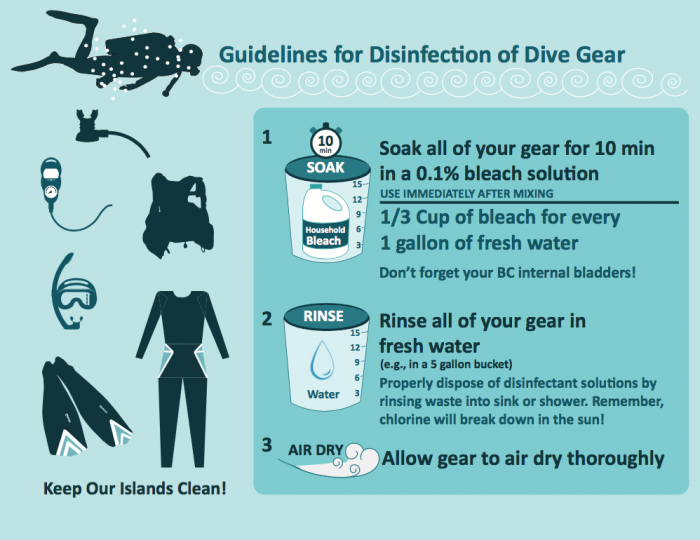Special contribution from Sonora Meiling,sonora.meiling@students.uvi.edu
A deadly coral disease, identified on the coral reefs of St. Thomas in January 2019, continues to spread across the island. First seen at Flat Cay, just south of the St. Thomas airport, what researchers at the University of the Virgin Islands believe to be stony coral tissue loss disease (SCTLD) has spread from the Flat Cay area east past Buck Island on the south side of the island, and around the west end to the north side, where it has reached as far east as Inner Brass island. Resource managers on neighboring islands are monitoring reef health and formulating response plans for if and when the disease reaches their reefs. Fishermen, snorkelers, and divers are asked to help by reporting signs of unhealthy corals (to https://dpnr.vi.gov/czm/sctld/) or diving with supporting dive shops.
In a manner of seven months, close to 50% of the living coral at Flat Cay- a reef system just south of the St. Thomas airport- died. This unprecedented mortality can be attributed to the emergence of a novel disease that researchers at the University of the Virgin Islands (UVI)
Center for Marine and Environmental Studies believe to be stony coral tissue loss disease (SCTLD). SCTLD was first discovered off the coast of Miami in 2014 and has since decimated reefs along the entire Florida Reef Tract and across the Caribbean. Its emergence in 2014 has been related to back to back coral bleaching events in 2014 and 2015 as well as the Port of
Miami dredging operations. Since the arrival of SCTLD to St. Thomas in January of 2019, it has continued to spread to reefs around the island. As of early November, the disease was seen on reefs as far east as Santa Maria on the north side and Capella island on the south side. During the National Oceanic and Atmospheric Administration’s (NOAA) National Coral Reef Monitoring Program -that took place in August of 2019- divers discovered diseased reefs as far west as Sail Rock. Although the disease is rapidly spreading, it has yet to be observed on St. John, St. Croix, or Puerto Rico.

In preparation for the arrival of SCTLD to St. Croix, Leslie Henderson -the Coral Reef Initiative Coordinator for the VI Department of Planning and Natural Resources- and Austen Stovall -the NOAA National Coral Reef Management Fellow for the VI- have been coordinating “strike teams.” These strike teams have been scouting the island for disease, securing resources for intervention, and building disease response kits. In coordination with the Caribbean Oceanic Restoration and Education Foundation (CORE) and the National Park on St. John, the strike teams are also developing a disease identification training so that the public can help with response efforts.
On August 24th, 2019 UVI and DPNR launched the Hunt for Coral Disease, a citizen science effort to track the disease. The goal of the Hunt is to concentrate efforts around the island on identifying where the disease is present and where it is absent. Although initially designed to be a two-week call for help, UVI and DPNR are asking that reports still be submitted and that all impaired corals still be reported to https://dpnr.vi.gov/czm/sctld/.
The University of the Virgin Islands, with funding from NOAA’s Coral Reef Conservation Program and support from The Nature Conservancy, hosted an international workshop November 6-7 to inform and facilitate the beginning stages of disease response plans for the U.S. and British territories in the northern Caribbean. Researchers and resource managers from all three U.S. Virgin Islands, the British Virgin Islands, Florida, and Puerto Rico attended to share information and brainstorm solutions to this ecological state of emergency.
Another way to get involved is to visit the Red Hook Dive Center
(https://www.redhookdivecenter.com/) for their Educational Dive Days, where you will be able to dive with a UVI researcher, learn how to identify the disease and help with research. For more long term assistance, trained divers on St. Thomas can contact CORE by emailing jasonquetel@gmail.com. If on St. Croix contact the strike teams by email austen.stovall@dpnr.vi.gov. If fishing, diving, or snorkeling in the disease zone (see map below), researchers are asking that you decontaminate anything that contacted water by soaking it in a mild bleach solution (0.1% or ⅓ cup of bleach per gallon of water) for ten minutes.




